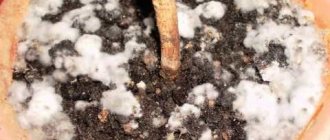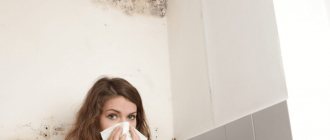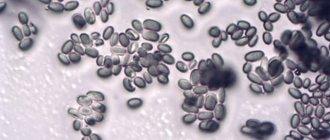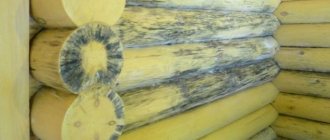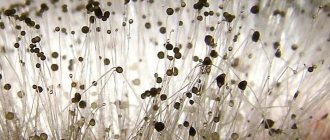Mold easily grows in any basement or cellar. The reason for this is a favorable environment: high humidity, poor ventilation system or poor quality waterproofing.
To prevent this, you need to constantly perform preventive work. If the moldy fungus has already managed to penetrate into the cellar space and is quickly spreading there, folk methods or effective modern drugs will help get rid of it.
What is mold
This substance is a fungal colony. Its spores constantly hover in the air and, when a favorable environment arises, they attach themselves to a suitable surface and begin to quickly take over space and reproduce. To do this, the fungus needs high air temperature and high humidity.
The surfaces on which mold can live are very different. The colony will successfully develop on wood, concrete, brick and other materials. It gradually takes over walls and ceilings, moves to the ceiling and other building structures. Over time, the fungus penetrates the thickness of walls and ceilings and destroys the material. Therefore, if steps are not taken in time to destroy the colony, the house will soon need to be repaired or even rebuilt.
Important! Separate black, brown and white mold. The shade of the fungus indicates class and the age of the colony. Often the color of mold is influenced by the nature of the surface where it grows.
Molds do not develop on their own. Usually there are objective prerequisites for this. The causes of mold in the cellar are:
- insufficient supply of fresh air, poor operation of the ventilation system or its clogging;
- accumulation of condensation as a result of increased moisture or lack of ventilation;
- poor circulation and air stagnation in the cellar space;
- finding rotten foods in storage, which are an excellent breeding ground for the colony;
- use of wood affected by mold as a building material.
How to remove mold from a cellar
It's high time to do something
. There are situations when the cellar is dry and clean, air masses penetrate into the ventilation unhindered, but mold still appears in the corners and on the ceiling
The reason for its occurrence may be products that have been stored in it for a long time, have become moldy and now fungal spores are actively growing on the walls.
In this case, it is urgent to carry out disinfection and figure out how and with what to treat the cellar against mold:
- We clear the cellar of all products, shelves, cans, etc. stored in it.
- After this, we clean the surfaces of the walls and ceilings where mold grows with a metal spatula. If the floor is earthen, then the plaster that has fallen away from the walls will have to be removed from the cellar along with 10 cm of earth. If the floor is concrete, then the plaster is carefully collected in bags and thrown away.
Under what circumstances does fungus grow in the cellar?
Mold does not always appear in the basement. To do this, the following conditions must be simultaneously met:
- The appearance of mold spores in the airspace of the utility room. They can be carried along with food, on human skin or animal fur.
- Presence of a nutrient organic medium. This could be paper, wood fibers, peat pots, fertile soil.
- Microclimate with high humidity and temperature at +20 degrees. Stagnant air increases the likelihood of mold growth.
Not all types of mold require air heating above +20 degrees. There are fungi that successfully reproduce even at 0 degrees.
It is also necessary to note the quality of the ventilation system. The freely circulating air flow does not allow mold spores to gain a foothold on the surface. Therefore, where the air is stagnant, mold forms more often. The movement of air masses in the corners of the room is especially difficult. Therefore, mold grows there more often.
High-quality ventilation does not allow excess moisture to accumulate in the utility room, resulting from a significant difference in temperature between outside and inside or due to increased humidity. Spores are unable to take hold and germinate, even if they are present on structures, but there are no suitable conditions for development. Therefore, the main reason for the development of mold in the cellar is considered to be poor-quality ventilation.
Why is mold in the basement dangerous?
There are several types of mold that can be found in basements, each of which is dangerous in its own way. Most often, underground storage facilities are inhabited by:
- blue mold;
- white mold;
- black mold.
Inhalation of spores of these types of fungus can lead to the following consequences for human health:
- migraine;
- sinusitis;
- bleeding;
- pneumonia;
- vomit;
- stomach pain.
In addition, the fungus can also harm the structure itself. The destruction of building materials is most often caused by white mold. It accelerates the process of rotting of wooden shelves and leads to a decrease in the strength of concrete floors.
Health harm from mold
Not all people know why white mold in the basement is dangerous for building structures and for health. In addition to the danger of injury due to a floor or ceiling destroyed by fungus, mold causes many diseases. Contact with spores of a fungal colony is possible directly with the skin, after inhaling particles along with air, or through eating foods contaminated with the fungus.
Most types of mold reproduce at an incredible rate. After all, just 1 square meter of a colony throws over a billion spores into space. Because of this, after penetration into the body, the fungus provokes various diseases:
- dermatological diseases that develop as a consequence of an allergic reaction;
- diseases of the upper respiratory tract, including sinusitis, nosebleeds, difficulty breathing, chronic runny nose;
- headache and dizziness;
- diseases of the digestive system;
- anemia and exhaustion of the body.
When a person is constantly in contact with mold, serious diseases develop that lead to disability. Elderly people, those weakened by illness, and children are especially sensitive to such proximity.
Important! You can detect the presence of an allergic reaction to mold by passing the appropriate tests. If the diagnosis is confirmed, measures must be taken to destroy the fungal colony.
Harm to health - myth or reality
Spores actively grow and multiply, moving with the help of air, damaging materials and structural integrity. If it smells musty, it means fungus, namely bacterial breakdown products such as proteins, cell wall particles (glucans) and volatile organic compounds.
The fungus may be hidden from the human eye, but the smell will immediately reveal its presence. If you discover such a problem, you should immediately begin processing the basement.
Fungus is not only disgusting and unsightly, it can also lead to health problems.
It produces allergens and irritants that lead to allergic substances. Some of its forms release mycotoxins that are hazardous to health. By inhaling the spores, after some time the child and adult will develop symptoms of hay fever, sneezing, runny nose, eyes will turn red when entering a room, dermatitis (skin rash).
Allergic reactions may appear immediately or develop gradually. They can cause asthma attacks.
In addition, spores lead to irritation of the eyes, skin, nose, throat and lungs.
Research into mold and its impact on human health is ongoing, but has already identified several diseases that the fungus can cause.
These include:
- Infections. Frequent visits to the basement increases the risk of developing bronchitis and respiratory infections, but this theory has not been proven. Because of this, bronchopulmonary aspergillosis and thrush develop.
- Pulmonary hemorrhage. In the 1990s, several children in Cleveland developed pulmonary hemorrhage. One of these children died. Preliminary studies have identified exposure to molds, particularly black mycotoxins.
- Hair loss. This symptom does not appear immediately. Hair begins to fall out 3-6 months after the appearance of the fungus, when it is already actively multiplying and producing dangerous toxic substances.
- Household members often experience headaches. They suffer from psychological depression and chronic fatigue.
The fungus also has the effect of suppressing the immune system. The person feels overwhelmed. The disease does not have time to recede before new signs appear.
This is why it is so important to get rid of mold in the basement as soon as it is discovered, rather than waiting for the right moment or warm weather.
Ways to fight
To completely destroy a mold colony, you need to put in a lot of effort and spend a lot of time. Before treating the room with special preparations, it is necessary to eliminate malfunctions in the ventilation system. Adjust the temperature and humidity levels. Otherwise, despite all efforts, the mold will grow again. Only an integrated approach will help destroy the enemy. The fight against mold in the basement is carried out in several stages.
Preparing the premises
Before getting rid of fungus in a cellar or basement, the room is completely cleared of the objects located there. They take out all products, tools and equipment. This will free up the work front and open access to possible places where fungus accumulates. Removed furniture is also treated with special preparations to avoid re-infection.
The cellar room is thoroughly cleaned and all mold is removed. If building structures are deeply affected by fungus, the parts are replaced with new ones. The earthen floor in the cellar is probably already contaminated with mold spores. Therefore, 20 cm of soil is removed and replaced with new one.
The cleaned cellar room is thoroughly dried. Only after this is it treated with special preparations to completely eliminate the fungus.
Destruction of a moldy colony
Simply removing visible mold and removing fungus in the cellar is not enough for complete destruction. Fungal spores have already penetrated into building structures and surfaces. Therefore, to combat mold in the cellar, they are treated with special antifungal and disinfectant preparations. You can purchase such products at construction and hardware stores. In this case, a good result can be achieved using folk recipes against mold. They are effective and do not harm human health.
Sulfur checker
This device kills mold with sulfur dioxide vapor. The device is very easy to use and effective, so it is recommended to use it first. Before processing, all ventilation holes in the cellar are closed to block air access. The checker is then placed in a metal container and set on fire. Immediately after this, the room is left and the entrance is tightly closed. After 5-6 hours, the cellar is ventilated to remove remaining vapors. Then the floor is covered with slaked lime to remove excess moisture.
Important! Sulfur dioxide is not only harmful to mold. It affects the health of humans and domestic animals. Therefore, they must leave home during treatment.
Vinegar
This product has good cleaning ability and destroys mold spores. White undiluted vinegar is poured into a convenient container. Then dip a brush in the liquid and treat all surfaces in the basement. There is no need to wash the substance with water. 12 hours after treatment, the entrance to the basement and ventilation are opened to get rid of the smell.
Bleaching
The method of getting rid of mold using preparations containing chlorine is comparable in its effectiveness to the action of a sulfur bomb. Any product that contains high concentrations of chlorine is suitable for this method. Typically, inexpensive chlorine bleaches are used, for example, “Belizna”. It is diluted in water, adding 10 parts of water to 1 part of the active substance. Then the liquid is applied to all the walls, ceiling and surfaces of the shelving in the cellar.
Lime
Before using lime to remove mold, the cellar is treated with Dezaktin. It is diluted with water according to the instructions and applied to walls, ceilings and other surfaces. Lime is then applied in one of the following ways:
- 0.5 kg of bleach and 0.2 kg of formaldehyde are dissolved in 10 liters of water. All surfaces in the cellar are coated with this liquid. After this, dry the room and ventilate it.
- 0.5 kg of slaked lime and 50 g of copper sulfate are diluted in 10 liters of water. A spray bottle is used to distribute this solution.
Lemon acid
Using citric acid, you can successfully fight mold in the basement of a private house. To do this, dissolve 100 grams of crystals in 10 liters of water. The resulting solution is sprayed into the cellar. After this treatment, the room is simply dried.
Copper sulfate
Sometimes treating all surfaces with copper sulfate helps remove fungus in the basement of a wooden house. To do this, prepare a solution of 30 liters of water, 250 g of copper sulfate and 2 kg of quicklime. The liquid is applied to the walls, floor and ceiling in the cellar or basement using a paint roller or brush.
Borax
You can get rid of mold in the cellar, if it has appeared there, using borax powder. To do this, prepare a solution of 3 liters of water and 200 g of borax. All surfaces in the cellar are coated with the prepared liquid. It is suitable for treating an attic, shed, garage or basement. To make the result more effective, the solution is not washed off.
Important! When treating a room with a borax solution, wear rubber gloves, as the drug corrodes the skin.
Grapefruit Seed Extract
Treatment with this substance is more of a preventative measure and helps to avoid mold infection. To prepare the solution, take 0.5 liters of water and pour in 20 drops of grapefruit seed extract. The liquid is poured into a spray bottle and all surfaces in the treated area are sprayed. There is no need to rinse off the composition.
Tea tree oil
Tea tree has antibacterial properties. Therefore, its oil ester is able to remove mold. The product is mixed with water and sprayed throughout the cellar. After a few hours, the drug will take effect and the mold spores will die. There is no need to rinse this product off.
Hydrogen peroxide
Hydrogen peroxide has good antifungal and antibacterial effects. Therefore, it is recommended to use it to clean a room of mold. You can use this tool in two ways:
- mix half and half with water and spray all surfaces in the basement;
- coat the walls, floor and ceiling, as well as shelving with undiluted peroxide.
Bleach with slaked lime
Another effective solution for removing mold is prepared from 1 liter of water, 3 tbsp. l. bleach and the same volume of slaked lime. The liquid is thoroughly mixed and applied to all surfaces in the cellar.
Boric acid
Another good way to solve the problem is to treat the cellar against mold and mildew with a solution containing boric acid. To do this, dissolve 1 kg of salt in 5 liters of warm water and add 100 g of boric acid. The ingredients are mixed until completely dissolved and sprayed throughout the room.
Using an ultraviolet lamp
Another way to remove mold in the cellar is exposure to ultraviolet rays. This treatment method will require a powerful quartz lamp or a bactericidal one. It is installed in the center of the cellar. If the infection is concentrated in one area, the lamp is directed towards this place. Then plug the device into the network and leave it for up to 12 hours.
Important! Ultraviolet rays are harmful to the eyes. Therefore, when working with a quartz lamp, they are protected with special glasses. Immediately after connecting the device to the network, they leave the room.
Cleaning the basement with a vacuum cleaner
To reduce the amount of mold and to prevent allergic diseases due to the impact of its spores, it is useful to clean the cellar room, as well as other rooms in the house, with a vacuum cleaner with a HEPA filter. The pores of such a filter are so small that they can retain not only ordinary dust, but also microscopic fungal spores. Therefore, preventive treatment with a HEPA filter helps get rid of allergens and maintain health.
What is mold?
Mold is a type of fungus that consists of many microorganisms. Its cells form hyphae - fibers similar to long threads. Reproduces using spores. They are very light and are carried by air currents until they reach conditions favorable for germination. Depending on the type, mold can develop on food, wood, and other organic matter. It also affects building materials: concrete, brick.
Fungus
In the basement of a private house or cellar, fungal spores end up on a person’s clothes and shoes, along with vegetables and fruits.
Precautionary measures
Since most anti-mold products are quite dangerous if handled carelessly, basement treatment is carried out using personal protective equipment. To do this, before starting work, put on rubber gloves, a respirator or mask, and safety glasses. Exposed parts of the body are protected with a special suit.
Solutions prepared for treatment should not be touched or inhaled. After the antifungal solution is applied to the walls and other surfaces, the room must be left and the entrance closed for several hours.
Important! Do not eat foods contaminated with mold. They will definitely be thrown out.
Harm from mold
Fungal mold spores are a pathogenic microflora that can cause great harm not only to the room in which they develop, but also to people and their pets.
For living organisms
The fungus multiplies not only by moving on surfaces, its spores fly in the air and can enter the body through inhalation. Going down into the cellar, the housewife can introduce mold spores into the house, thereby endangering her household. Their penetration into a living organism can also occur from the hands during cooking or eating.
An annoying dry cough, causeless headaches, aching joints, allergic manifestations, asthmatic syndrome - this is just a small list of diseases that can develop under the influence of fungal spores.
Prevention
After mold is removed from the cellar, it is important to create conditions under which re-infection of the room will be impossible. To do this, you need to maintain a certain microclimate:
- Check the quality of ventilation. If it does not work, troubleshoot. If there is no ventilation at all, it needs to be done.
- The basement is insulated and high-quality waterproofing is created from the outside. It is best to do this during the construction stage, but if desired, work can be carried out after its completion.
- They make a window that is periodically opened to let sunlight into the room.
There should be good air circulation in the cellar so that it does not stagnate. To do this, install open racks with lattice shelves. All products and things are laid out on these structures so that they do not come into contact with the walls.
It is important to monitor the humidity level. If condensation appears, the room is dried and the cause of its formation is eliminated. It is recommended to monitor temperature and humidity using a household thermometer and hygrometer.
Danger of fungus to humans
Many people do not suspect that mold poses a huge danger to human health and even life, not only for building materials. A damaged ceiling or floor (especially wood) can cause serious injury. In most cases, mold affects human health in the following ways:
- through direct contact with skin;
- human respiratory and circulatory system;
- eating foods contaminated with fungi.
Spores of many types of mold are toxic and multiply very quickly (1 square meter of mold can release more than a billion spores into the air). In view of this, if it enters the human body, many ailments can develop.
The unpleasant consequences of contact with mold fungi are the following pathologies:
- dermatological diseases occurring against the background of allergic reactions (mycoses);
- pathologies of the upper respiratory tract (nosebleeds, sinusitis, severe runny nose, many patients report difficulty breathing);
- dizziness, headaches;
- stomach upsets, digestive problems, attacks of nausea, vomiting;
- exhaustion of the body, anemia.
The long-term influence of mold on the human body leads to problems in the functioning of the kidneys and liver, even internal bleeding occurs, and sometimes pulmonary emphysema. The risk group includes elderly patients, children, people with weakened immune systems; patients who have survived fungal infections are especially susceptible to damage.
Note! Mold allergies can be diagnosed in many laboratories. If you discover such a problem, urgently get rid of the causative agent of the problem.
Reviews
Pavel, 45 years old
I recently discovered black mold in the corners of my basement. It turned out that condensation was accumulating on the walls. We had to urgently dry the room, and we got rid of the mold with a sulfur bomb. A very effective remedy.
Igor, 37 years old
Mold developed on the potatoes in the cellar because it was too warm. We ventilated the cellar and adjusted the ventilation. Of course, I had to throw out some of the potatoes. For prevention, all the walls were coated with bleach.
How to get rid of fungus in the underground of a wooden house
The smaller the basement, the more difficult it is to ensure normal air circulation in it. Therefore, special attention is paid to openings in underground walls . They must be end-to-end with access to the street and located opposite each other at a height of at least 40 cm from ground level. The optimal ones are squares with sides of 15-20 cm, covered with mesh (to prevent the penetration of rodents and debris).
Treating a small room with disinfectants containing harmful fumes is dangerous for humans . Therefore, in order to get rid of mold in the basement of a wooden house, it is better to use slightly different methods of combating mold, determining how to eliminate the problem.
- The same smoke bombs as described above will do.
- You can use hydrochloric acid, but in a different way - pour it over table salt. In this case, the container should be glass or ceramic, and it should be placed on the floor in the center of the room.
- White moss powder absorbs harmful spores well. It is poured into metal containers and placed in the corners of the basement.
In a wooden house, using an electric fireplace to dry the underground room is risky due to the possibility of fire. The option of a professional hairdryer in a small basement is also out of the question. Here you can apply popular recommendations - lay out heated ceramic bricks in the underground on the ground along the walls . They absorb moisture well and can be heated several times.
If possible, whitewashing the inside of the walls can help. You can also mix lime with underground soil.
How to get rid of mold on boards and joists
If the damage is not significant, watch the video instructions on YouTube. In case of serious areas of rot, it is recommended to cut out the boards with joists and replace them with new ones treated with bioprotection.
What types of fungus are there in the cellar and how to identify them?
Fungus is the most ancient organism on the planet. Mold is the popular name for fungus. In our conditions, in the house and office premises, the following types of fungus are found:
- Mold fungus. It usually occurs and appears on concrete, stone, as well as on any other surfaces treated with low-quality paint. Molds appear as spots of black, brown, green or blue. Such a fungus can destroy the entire decoration of the house and all the material, so it is only natural that we need to find the most effective means to fight mold in the cellar.
- Blue fungus. It is very dangerous for a wooden house, as it affects the structure of wooden coverings and stains the wood blue. The appearance of blue fungus leads to an increase in wood moisture content and the penetration of other types of mold. Pine is subject to these changes.
- Rotting fungus damages exclusively wooden surfaces. There are several types of this fungus:
- Bacterial rot. Negatively affects the strength of wood and colors it gray.
- Brown rot. Capable of splitting even the strongest wood.
- White rot. It destroys the material very quickly - white rot can destroy 4 cm of oak boards within a month.
Important! White mold in the basement is very dangerous and requires special attention. She is able to quickly move into any neighboring rooms.
Preventive recommendations
To prevent mold from becoming a permanent resident in the cellar, you need to take preventive measures:
- arrange good natural or forced ventilation;
- treat wooden structures with antiseptic impregnations;
- do not store vegetables or fruits infected with fungus;
- use quartz or bactericidal lamps;
- at the end of summer, carry out regular disinfection and ventilation.
No matter how difficult it may be, it is necessary to get rid of mold in the cellar. This will help maintain the health of family members, reduce repair costs and extend the life of the premises.
Preventive measures for the occurrence of fungus
If you have completely gotten rid of mold and mildew in your garage basement, don’t relax. Since spores are everywhere, they may come back again. What to do to prevent this from happening? There are some preventive measures.
First, if you store food in a garage cellar, make sure it is fresh. Rot will only facilitate the spread of microorganisms.
Secondly, monitor the condition of the premises from time to time. Ventilate it and remove excess moisture.
Thirdly, keep an eye on the water supply and sewerage (if any). If condensation forms due to temperature changes, insulate the basement.
In the summer, you can take the racks and shelves outside so that the sun can dry them. And from time to time treat the walls of the room with an antiseptic or that vitriol solution. Then you will not suffer from such a phenomenon as mold in the basement of the garage.
There are several ways to get rid of mold:
Using an antiseptic:
They have antibacterial and disinfectant effects. These include: Fongifluid Alpha solution, for prevention - Dal solution and Olymp-Stop mold is perfect. These products are safe for people as they do not contain chlorine. For convenience, they are available in the form of cans, suitable for small rooms. During the procedure, do not forget about the rules and personal safety measures. After treatment, it must be allowed to dry for at least a day.
Professional destruction using microwave drying of walls in Peski.
This is the ideal method for killing mold. After all, she does not like the heat and dryness that are used in the microwave drying method. This method will effectively get rid of mold, which is almost impossible to get rid of on your own. In a few minutes, the surface and walls are heated to a temperature of 65-70 degrees, moving in small areas, 25x25 cm. The penetration depth reaches 25-35 cm. It is important that the specialist always uses a laser pyrometer, because mold spores can survive even temperature 60 degrees. The positive qualities of the microwave method to remove mold are: speed of processing, it is possible to process any surfaces, treat places with difficult access, and most importantly, no chemicals are used and therefore it is absolutely safe for everyone around.
Traditional methods for eliminating mold in an apartment.
Let's highlight several effective methods - bleach, tea tree oil, baking soda, grapefruit seed extract, hydrogen peroxide, ammonia, borax. Choose an effective and convenient method.
Prevention of occurrence
To protect your premises from mold, you must follow the following rules:
- Regularly treat the walls of the basement or cellar with an antiseptic and ventilate.
- Carry out waterproofing work. One of the reasons for the proliferation of spores is humidity.
- Equip the room with an air purifier with a Nera filter.
- It is necessary to regularly clean rooms prone to mold. Wet places are wiped with a dry cloth.
- If there is heating in the basement, it is better not to turn it off, since the growth of active spores occurs when the room cools.
- Do not leave undried items in a basement prone to fungus.
- Containers with quicklime are placed in the corners of the room.
Important: only comprehensive compliance with preventive measures can prevent fungal proliferation.
Where do fungi and mold come from?
A successful mold control strategy is impossible without understanding the cause of its occurrence. Mold spores are microscopically small and can surround us literally everywhere. When mold spores find a place with optimal conditions for their life, they settle there and begin to develop, forming mycelium (mycelium), penetrating deep into materials and forming new spores.
The cellar is an ideal place for fungal growth for the following reasons:
- Lack of circulation - practically no air flows into the basement or cellar.
- High humidity.
- Formation of condensation.
- Poor waterproofing.
- Long-term storage of spoiled products.
- Sometimes shelf boards that are infected with wood fungus are used in the cellar.
- Close proximity to groundwater.
Conditions for reproduction are flexible
Why does one owner have fungus in the basement, but not another? In order for such “life” to appear, several conditions must be met. This:
- Spores in the air that can land on people, animals, and various products.
- Availability of a nutritious organic environment.
- Mold develops if the humidity level in the room is high and the air temperature is 20 degrees or higher.
Various types of mold can lose their ability to reproduce and develop at low air temperatures - from 0° and below. Separately, it is necessary to say about ventilation. Ventilation systems are designed to ensure normal air circulation. When there are movements of air currents, this prevents the spores from attaching to the surface.
In the corners of rooms, air flows often move weakly - it is in the corners that these colonies accumulate.
The ventilation system also removes excess moisture from the air, which is formed due to high humidity outside the cellar or due to a large temperature difference between the outside of the house and the inside of the basement. If there are traces of a fungal colony on the wall, but there are no conditions for reproduction, then germination will not occur. It turns out that the cause of everything is poor ventilation.
On video: the reasons for the appearance of fungus on the walls.
How to treat a cellar for mold and mildew
Before removing mold, you should prepare the cellar:
- The affected plaster must be completely removed and subsequently replaced. To prevent dust from flying into your eyes during work, it is recommended to moisten the surfaces with water.
- Concrete or brick walls and floors must be thoroughly cleaned of fungus using a metal brush or spatula.
- It is impossible to leave mold on wood, since the porous structure of the natural material is a good environment for the subsequent development of microorganisms. If possible, wooden structures should be replaced with new ones.
Treatment of the cellar with folk remedies
You can remove mold using folk remedies; they also recommend periodic preventive treatments:
Whiteness and bleaches. Effectively destroys mold due to sodium hypochlorite. However, bleach is effective only on non-porous surfaces - its simplicity is in some sense “compensated” by the narrow range of applications. In addition, this method cannot be called harmless: bleach contains components that can corrode the skin in the absence of protection in the form of rubber gloves.
Vinegar. The method works because acetic acid is destructive to most types of molds. In addition, it is harmless to humans: when vinegar evaporates, it does not release toxic substances. However, after treating a surface affected by mold, it is better to ventilate the room.
Hydrogen peroxide 3%. kills mold fungi. By applying it to a prepared—cleaned—surface, you can get rid of harmful sporophytes for a long time. However, it is better not to apply it to painted surfaces due to its whitening effect.
Ammonia. Diluted in water in a ratio of one to one, you can easily get rid of black fungus
However, you should work with it with great care, observing safety precautions and thoroughly ventilating the room.
Baking soda solution. In the ratio of one spoon of soda to a glass of water, it is harmless to humans, but harmful to mold.
Professional products
A hardware or hardware store sells special mold repellents. Before buying, check reviews on the Internet so as not to buy an expensive pacifier.
| Chemical | Materials that can be processed | Special properties, effect, operating principle, tips for use, etc. |
| "Antifungal" | Any materials except metal and polypropylene. | Added to plaster, putty, and water-based paints. Can be used as a disinfectant and is effective in combating small pockets of mold. |
| "Neomid" | Also applied to any surface except metal and polypropylene. | Improved version of Antifungal. An effective concentrate that destroys not only the external manifestations of mold, but also the entire mycelium, eliminating the risk of new lesions. |
| "Atlas Mykos" | Universal, suitable for use on any surface. Does not leave stains, becoming transparent after drying. | An effective Polish remedy of a new generation. Produced in the form of a concentrate, it is used as a prophylactic agent, as well as in the fight against small pockets of mold. Works against lichens and algae. |
| "Izohan Grzybostop" | Effective when treating concrete surfaces or other building materials. | Just like Atlas Mykos, it is sold in the form of a concentrate, which must be diluted before use. It has high chemical activity and quickly penetrates the material, destroying mycelium of black or white mold. |
| "Spectrum Fungicide" | Effective on wooden surfaces, concrete and metal, as well as other materials. | Suitable for eliminating mold in rooms with high humidity, unlike other chemicals, it is effective even in conditions of dampness and low temperature. |
| "Argo Biopag-D" | Suitable for indoor and outdoor use. | The most effective remedy in case of white mold in the cellar. |
| "Belinka" | Suitable for processing any surfaces. | An effective means of combating mold fungus, allowing you to get rid of it quickly. |





